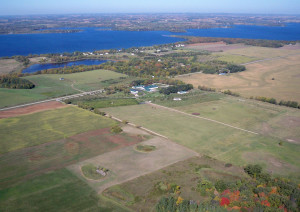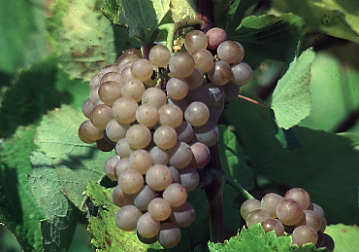Coming Soon: A New Red Wine That’s a Pearl

Maria Milano and Steve Johnson of Parallel 44 Winery will release their Petite Pearl during 2013
A new hybrid red wine, Petite Pearl, is now in production at several Midwest wineries and should be available soon. 2012 will be the first commercial vintage of Petite Pearl. Previously, only test samples have been made.
Bred by Tom Plocher in 1996, Petite Pearl is a cross between MN 1094 and E.S. 4-7-26. (“MN” and “E.S” are abbreviations for The University of Minnesota and Elmer Swenson.) According to Plocher, Petite Pearl was developed near Hugo, Minnesota and will be certfied to export to Quebec.
Several commercial wineries are currently making Petite Pearl. The first commercial winery reported to have bottled Petite Pearl is Bear Creek Winery in Fargo, North Dakota. According to Rod Ballinger of Bear Creek, “It is a very well structured, complex wine. Petite Pearl is deep ruby-red and should age well. It’s too early to be certain, but it seems very promising. I have some more of it on French oak right now.”
Another winery preparing to release Petite Pearl wines is Parallel 44 Vineyard and Winery in Kewaunee, Wisconsin. Maria Milano and Steve Johnson, owners of Parallel 44, say that they have 55 gallons of Petite Pearl on oak that will be bottled in March or April, if all goes according to plan.
To continue reading this post, you must either subscribe or login.[login_form][show_to accesslevel=”annual-membership” ]
Johnson said that the grapes were left on their skins for 3-4 days for color extraction and were fermented in stainless steel tanks. He said that temperature control for such a small batch was difficult, resulting in a warm fermentation.
See related story May 2013: Petite Pearl in the Bottle at Parallel 44
Parallel 44 used a Lallemand D254 yeast for its Petite Pearl. The wine was aged in neutral oak to limit oak extraction and not cover up the fruit. Johnson said that he will cold stabilize the wine before bottling. He did not conduct malolactic fermentation this year, but may try in the future. “This is an exceptional cold climate red, it has an almost Syrah like quality with black pepper flavors,” Johnson said.
[stextbox id=”custom” caption=”U.S. Release Dates for Cold Climate Red Varietals” shadow=”true” float=”true” align=”right” width=”200″]
- Petite Pearl- 1996
- Frontenac- 1996
- Marquette- 1996
- St. Croix- 1983
- Chambourcin- 1963
- Leon Millot- early 50’s
- Baco Noir- 1951
- Marechal Foch- 1951
[/stextbox]
Maria Milano of Parallel 44 spoke highly of Petite Pearl’s flavor and aroma. “It’s amazingly smooth, I even taste some blue fruit. Petite Pearl is more vinifera-like than any hybrid I’ve ever tasted.”
Parallel 44’s Petite Pearl is estate grown with a 2012 debut vintage. According to Johnson, the first harvest was small and there were some problems with frost damage. He said that their two acres of Petite Peal were planted in 2010 with the potential to yield 2-3 tons per acre. He described the clusters as tight and small and said they tend to establish good cordons.
Tom Plocher, who developed Petite Pearl, grows this new varietal in his vineyard north of the Twin Cities where Growing Degree Days (GDD) of 1350-1400 Celsius are common. He uses a high wire cordon trellis system. Plocher reports that Petite Pearl has sufficient vigor on its own roots, requires very little management, and puts out few lateral shoots.
Petite Pearl clusters are small and dense, about 90-110 grams each. Plocher said that there is still much to learn about making wine from Petite Pearl. He reports that in areas where it has not ripened fully, a quality wine can still be produced. ‘It has quite a range to make wine from it.”
Plocher’s reported harvest numbers are 23-24 brix, a pH of 3.40-3.45, and 9 g/L of acid. He said that it takes about two weeks to go from 22 to 24 brix at the end of the season. ‘It’s worth the wait to get the flavor complexities. When they develop, the berries are like jam inside.” Among the flavor complexities mentioned by Plocher are spices, herbs, and even celery. He said that he has made a dry red that finishes balanced, with soft tannins similar to Marquette.

Carlos Creek Winery owner Tami Bredeson (right) will release a dry Petite Pearl in 2014
Gilles Benoit, the winemaker at Vignobles des Pins in Sabrevois, Quebec, has been working with Petite Pearl for a short time, but he said it is a very useful grape for northern terroirs. He believes that late bud break, low disease susceptibility, and good productivity give it an advantage over other hybrid reds.
On the winemaking side, Benoit has experimented with making wine from this grape in several ways. Sometimes he starts with one week of skin contact with Lallemand D254 and fermentation temperatures between 25-28 degrees Celsius. He says the resulting wine has good body and balance, plenty of color, and complex varietal aromas with some herbal elements.
One problem Benoit has experienced is high pH before fermentation, which he said can be corrected with tartaric acid to bring acids down to 3.3. One method suggested by Benoit to counteract high pH is to split the harvest: one early harvest for low pH and fruitiness, and one late harvest for higher sugars, more tannin and color, and less acidity.
In addition, Benoit has made Petite Pearl from grapes that were picked early at about 18 brix. He said that these early harvest grapes do not need any acidity adjustments, but he does add sugar. Benoit has also experimented with whole crushed clusters to extract the stem tannins. He said this practice brings out a herbaceous element in the wine.
Petite Pearl makes ‘a fresh and fruity wine, with aromas similar to Gamay,” Benoit said.
Dell Schott with Bevens Creek in Minnesota has tried different fermentation techniques with Petite Pearl. In one trial, Schott kept the grapes on their skins during a 27 day fermentation. He said this long fermentation gives the wine ‘soft mid-mouth tannins, and more fruitiness and complexity.” His preferred yeast is called Assmanhassen, which he says is steady and slow at cool temperatures. In addition, he punches the must down twice a day.
If the TA is between 5.5 and 7.0 g/L, Schott prefers not to use malolactic fermentation with Petite Pearl. He says that the ratio of malic to tartaric acid gives him this option. Maintaining the proper ratio of the two principal organic grape acids retains the freshness and fruitiness of the wine Schott believes.
‘The ratio of malic to tartaric acid with Petite Pearl is low even in cool summers. You really need the acid to benefit structure. With a long warm season you should be able to ripen the grapes to near perfection with weekly testing.” he said.
Schott said that there are three myths about Petite Pearl that should be dispelled. The first is that Petite Pearl is just a blending wine. He suggests that winemakers that are new to this variety should try to vinify it using a traditional 5-7 day warm fermentation. He said that techniques that Washington and Oregon winemakers use for Pinot Noir can be applied successfully to Petite Pearl.
The second myth, according to Schott, is that Petite Pearl has low yields. He said that with proper management, Petite Pearl can yield 3.5-4 tons per acre. The third myth is that Petite Pearl has Pinot Noir in its breeding heritage. ‘There is very little V. vinifera in its very complex heritage,” Schott said.
Tami Bredeson of Carlos Creek Winery in Alexandria, Minnesota, also has commercial Petite Pearl in the winery’s tanks now. Bredeson said the wine probably will not be available until 2014. Carlos Creek is making a dry red wine from their 2012 Petite Pearl harvest. According to Bredeson they are experimenting with different types of oak to determine what works best. ‘Petite Pearl makes an excellent, complex red but can also be done in an off-dry Rose style,” Bredeson said.

Carlos Creek Winery, Alexandria, Minnesota
Carlos Creek has 400 Petite Pearl vines which were planted three years ago. Bredeson says that they are extremely hardy, but slow-growing. She believes that their slow growth makes them stronger and more resilient.
Late bud break, mid-season ripening and the ability to tolerate temperatures as cold as -33F have been reported by most of the small number of people who are working with this variety. Petite Pearl seems to be promising for a Midwest variety, although there is still much to learn from it. From what has been reported about the test samples, this could be a Northern red wine that is well worth the wait.
[wp_geo_map]
[/show_to][password-recovery-link text=’Lost Password? Click here for password recovery.’]




